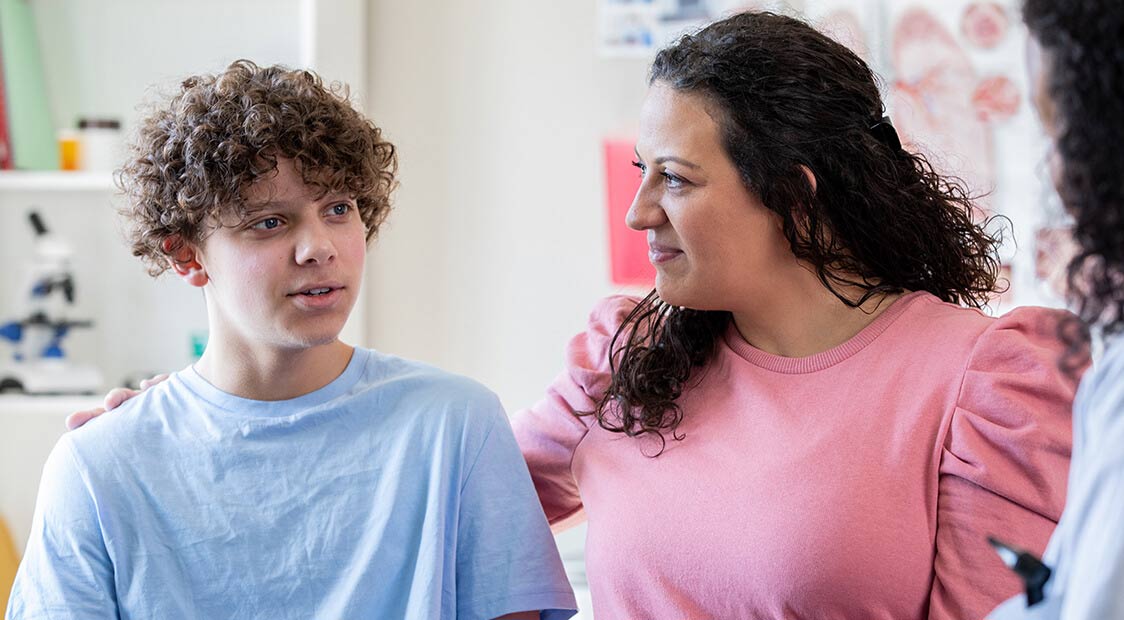How proton therapy reduces the risk of secondary cancers
By Bradlee Robbert and Christina L. Mershell
Share:

If you’ve researched proton therapy, you likely know it offers a lower risk of side effects when treating cancer. For many patients, concerns about side effects are top of mind after receiving a cancer diagnosis.
Common cancer treatment side effects such as hair loss, nausea and fatigue are often the first to come to mind. But have you ever considered that the radiation used to treat cancer could potentially cause another cancer? We call this secondary cancer.
What Is Secondary Cancer?
Secondary cancer is a new cancer that develops because of treatment for a previous cancer. Radiation therapy, while effective at destroying cancer cells, can also affect nearby healthy cells.
Radiation oncologists are doctors who treat cancer with radiation. They must give a strong enough dose to kill cancer cells. At the same time, they need to protect the healthy tissue around the cancer.
Radiation works by damaging the DNA of cells, preventing them from multiplying. While cancer cells typically cannot repair this damage, healthy cells can recover.
In some cases, radiation exposure can alter the DNA of healthy cells in a way that disrupts their normal function. These changes may not be immediately apparent and can take years—sometimes decades—to manifest. In rare cases, these disruptions can lead to developing secondary cancer around the original treatment area.
How Can We Treat Cancer with Radiation and Minimize the Risk of a Secondary Cancer?
Advancements in cancer treatment have led to proton beam therapy. This method allows doctors to give high doses of radiation directly to the tumor.
It also protects the healthy tissue around it. Proton therapy is different from traditional radiation.
It stops radiation at a specific point in the body. This helps prevent extra exposure beyond the tumor. Learn more about radiation v. proton therapy radiation.
To understand how this works, check out our Proton Radiation Therapy resource.
Research on Proton Therapy and Secondary Cancers
A key study published in March 2020 by Michael Xiang, MD, PhD, and his team looked at data from more than 450,000 patients. They studied nine types of cancer over an 11-year period.
The study found that patients who received proton beam therapy had a lower risk of getting secondary cancers. Researchers compared this to patients who received intensity-modulated radiation therapy (IMRT).
IMRT is a common type of photon radiation. The study compared IMRT with another technique called 3D conformal radiation therapy (3DCRT).
The study found that the risk of secondary cancers was similar for IMRT and 3DCRT. However, proton therapy showed a significant reduction in risk. This reduction was particularly notable in cancers of the head and neck, breast and prostate.
This study is important because it has a large sample size and includes many types of cancer. This makes the findings more useful for a wider audience.
The risk of getting secondary cancers from radiation treatment is low. However, better cancer treatments have resulted in longer survival rates. Younger patients or those who will live for many years after treatment have a higher long-term risk of secondary cancer. This risk is very important to consider.
The study also accounted for variations in age, income and sociodemographic factors to ensure accurate results. Some secondary cancers can take more than five to seven years to develop. Therefore, researchers should conduct ongoing follow-up research.
Advances in Proton Therapy: Pencil Beam Scanning
One of the newest advances in proton therapy is pencil beam scanning. This method improves the accuracy of radiation delivery.
This technique directs protons in a narrow beam. This beam closely matches the shape of the tumor. It helps reduce radiation exposure to nearby healthy tissues.
A 2019 study looked at the risk of secondary cancers in breast cancer patients. Proton therapy with pencil beam scanning reduces the risk of getting lung cancer as a secondary cancer.
Pediatric Patients and Secondary Cancer Risk
The risk of secondary cancers is particularly concerning for pediatric patients, as children have many decades of life ahead of them.
A research team studied data from more than 1,700 children. Dr. Daniel J. Indelicato from the University of Florida led the team. They collaborated with experts from several institutions. These include Emory University, Mayo Clinic Jacksonville, University of Kansas Medical Center, and Nemours Children’s Specialty Clinic.
The team focused on children treated with proton therapy. Their findings showed that secondary tumors were rare in the first ten years after proton therapy. The overall risk was just 1.7% ten years after treatment.
Some pediatric patients have genetic conditions that increase their risk of secondary cancers. However, even after considering these factors, the risk stayed low. This highlights the potential benefit of proton therapy in reducing long-term risks for young patients.
What Does Proton Therapy Mean to Me?
As research shows the long-term effects of radiation therapy, patients and doctors can make better treatment choices. By minimizing the risk of secondary cancers, proton therapy represents a significant step forward in cancer care.
If you have additional questions or would like more information about proton therapy, please contact us.
Xiang, M., Chang, D. T., & Pollom, E. L. (2020). Second cancer risk after primary cancer treatment with three-dimensional conformal, intensity-modulated, or proton beam radiation therapy. Cancer, 126(15), 3560–3568. https://doi.org/10.1002/cncr.32938
Paganetti, H., Depauw, N., Johnson, A., Forman, R. B., Lau, J., & Jimenez, R. (2020). The risk for developing a secondary cancer after breast radiation therapy: Comparison of photon and proton techniques. Radiotherapy and Oncology, 149, 212–218. https://doi.org/10.1016/j.radonc.2020.05.035
Indelicato, D. J., Bates, J. E., Mailhot Vega, R. B., Rotondo, R. L., Hoppe, B. S., Morris, C. G., Looi, W. S., Sandler, E. S., Aldana, P. R., & Bradley, J. A. (2021). Second tumor risk in children treated with proton therapy. Pediatric Blood & Cancer, 68(7), e28941. https://doi.org/10.1002/pbc.28941


